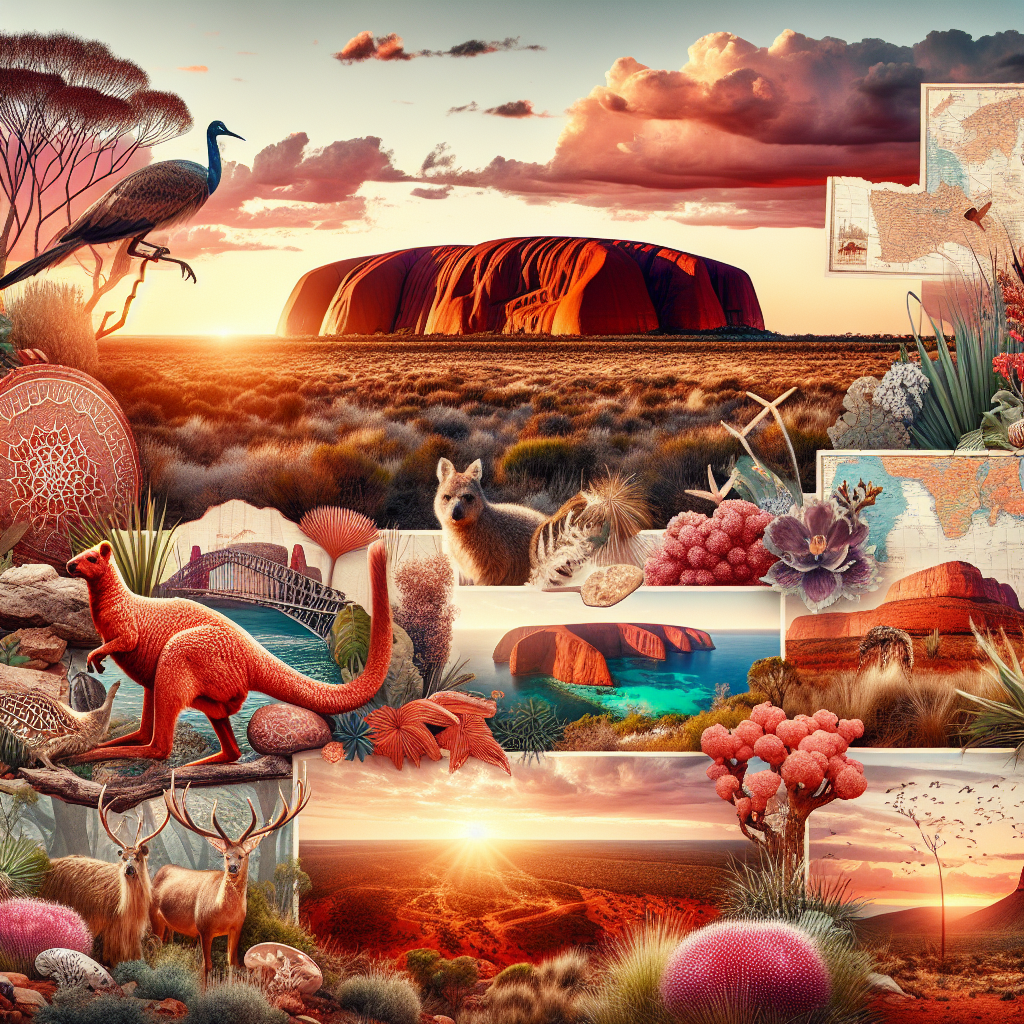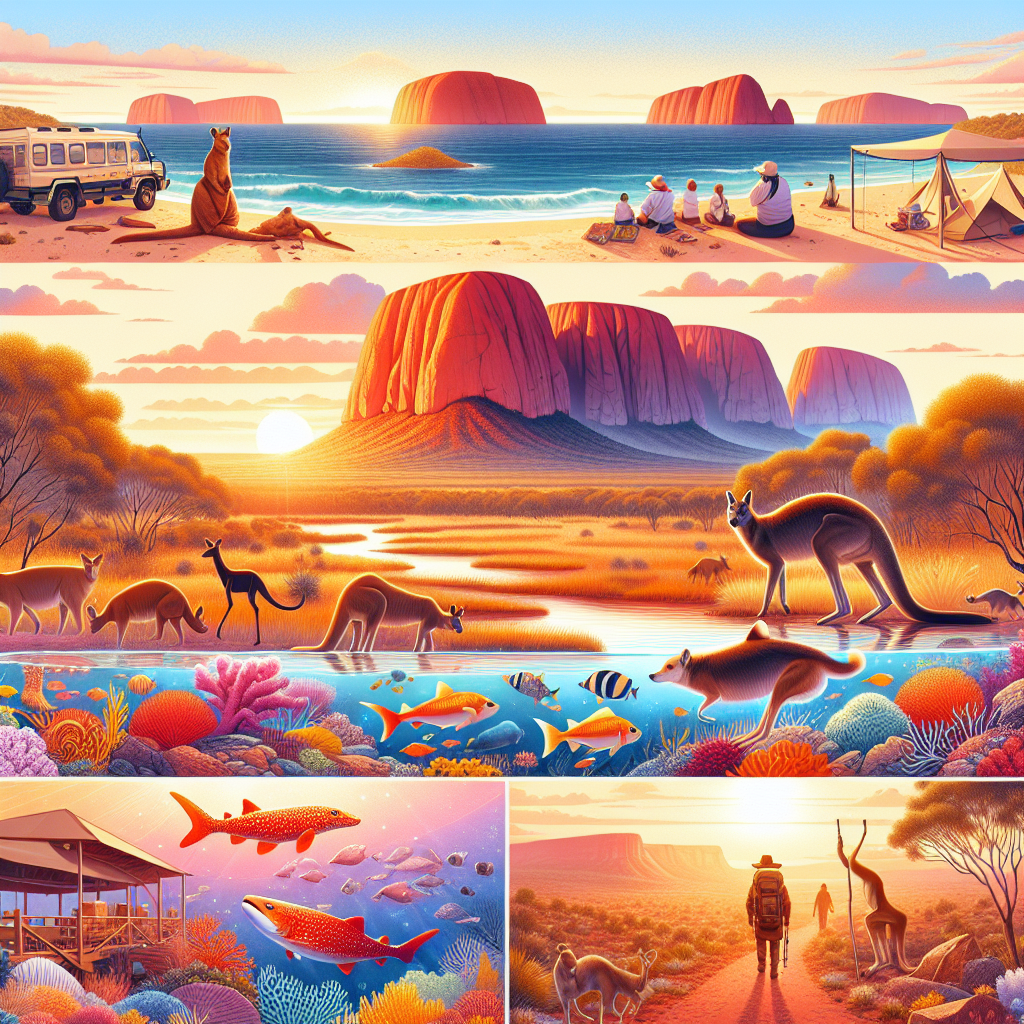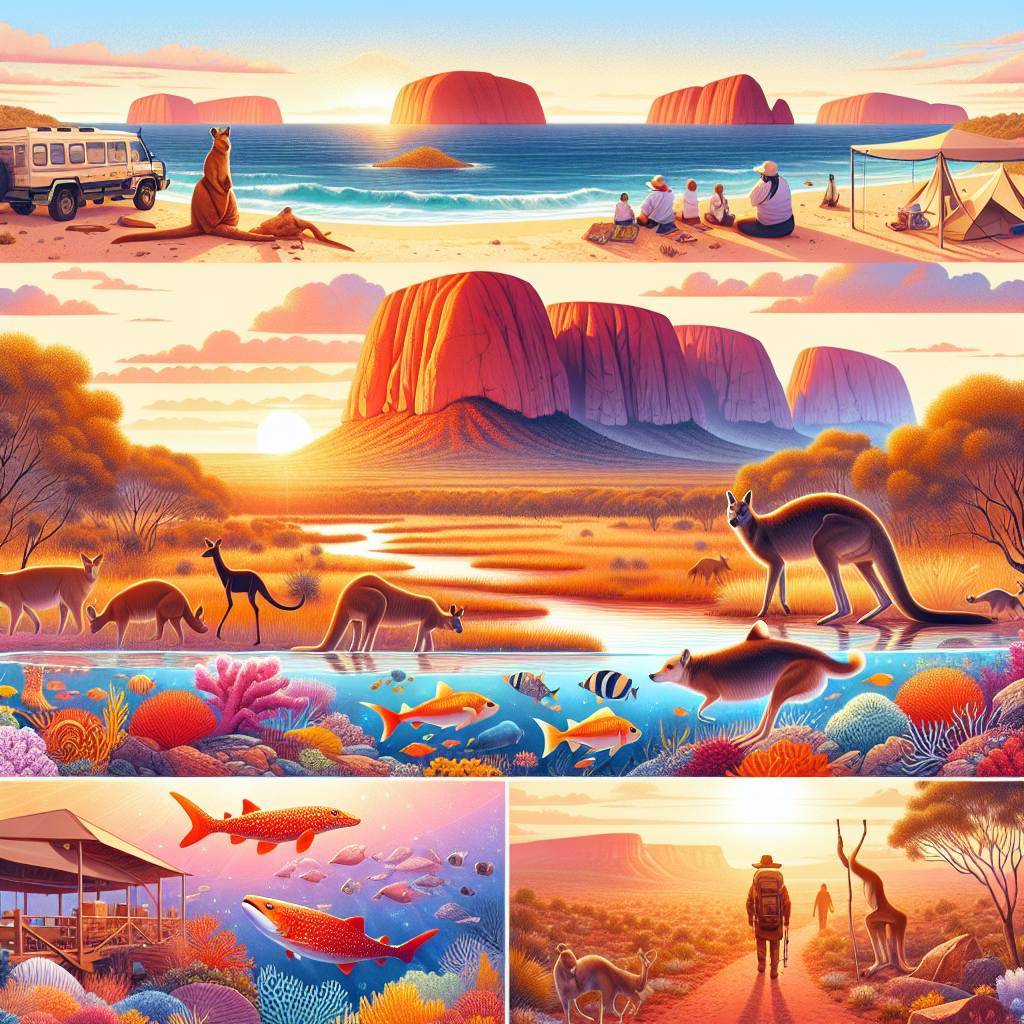Australia’s outback is a land full of wonders waiting to be discovered. From its vast red deserts and iconic rock formations to its unique wildlife and Aboriginal culture, the Australian outback is a truly captivating destination. Embark on a journey of exploration as you delve into the heart of this rugged landscape, immersing yourself in the untouched beauty that awaits at every turn. Whether you’re seeking adventure, solace, or a chance to connect with nature, the Australian outback offers an unforgettable experience that will leave you in awe of its untamed splendor. So pack your bags, embrace the spirit of adventure, and get ready to uncover the wonders of the Australian outback.

Location and Overview
Introduction to the Australian Outback
The Australian Outback is a vast and remote region that covers the majority of Australia’s landmass. It is known for its rugged landscapes, extreme temperatures, and unique ecosystems. Exploring the Outback offers an opportunity to experience the raw beauty and rich cultural heritage of this remarkable region.
Geographic Location
Located in the central and western parts of Australia, the Outback stretches across several states, including Queensland, New South Wales, South Australia, Western Australia, and the Northern Territory. It is characterized by vast desert landscapes, red-rock formations, and expansive plains, creating a striking contrast to the coastal regions of the country.
Size and Overview
Spanning over 2.5 million square miles, the Australian Outback is one of the largest desert wilderness areas in the world. It is home to a diverse range of habitats, including arid deserts, grasslands, and salt pans. Despite its harsh and isolated environment, the Outback is teeming with unique flora and fauna that have adapted to thrive in this challenging landscape.
Flora and Fauna
Unique Ecosystem
The Outback is renowned for its unique and fragile ecosystem, which has evolved over millions of years. It is a delicate balance of plants, animals, and the environment, all interconnected and dependent on one another. Despite the arid conditions, the Outback is home to a surprising array of plant and animal species, some of which are found nowhere else on Earth.
Diverse Plant Life
The Outback showcases a remarkable display of plant life, with a range of species adapted to survive in the harsh climate. From iconic acacia trees to drought-resistant grasses and stunning wildflowers, the Outback’s vegetation showcases an incredible spectrum of colors and adaptations. This plant diversity not only adds to the region’s aesthetic appeal but also plays a vital role in providing food and shelter for the unique wildlife that calls this place home.
Iconic Animal Species
The Outback is a haven for a wide variety of incredible animal species. From the majestic kangaroo and the elusive dingo to rare and endangered creatures like the bilby and the quokka, the Outback offers a chance to encounter these iconic Australian animals in their natural habitat. The region is also home to a vast array of bird species, including the magnificent wedge-tailed eagle and colorful parrots, making it a birdwatcher’s paradise.
Indigenous Culture
Traditional Owners
The Australian Outback has been inhabited by Indigenous peoples for over 50,000 years. These diverse cultures have strong connections to the land and maintain a deep spiritual and cultural connection to the Outback. The Outback is their ancestral homeland, and they are the traditional custodians of the land, passing down their knowledge and wisdom through generations.
Dreamtime Stories
Dreamtime stories are an integral part of Indigenous culture and are often depicted through art and storytelling. These narratives explain the creation of the land and its features, as well as the origins of significant animals and plants. Exploring the Outback provides an opportunity to learn about these ancient tales and gain a deeper understanding of the cultural significance they hold for Indigenous communities.
Aboriginal Art
Aboriginal art is a striking expression of Indigenous culture and can be seen throughout the Outback. From rock art depicting ancient stories to intricate dot paintings, these artistic works provide a glimpse into the rich cultural heritage of the region. Many communities welcome visitors to experience and learn about their art, offering the chance to support Indigenous artists while gaining an appreciation for their unique artistic traditions.
Climate and Weather
Extreme Temperatures
The Outback is known for its extreme temperatures, with scorching hot summers and chilly winters. Daytime temperatures often soar above 100 degrees Fahrenheit (38 degrees Celsius), while nights can bring freezing temperatures. It is essential to be prepared for these extreme weather conditions and take necessary precautions to ensure safety while exploring the region.
Rainfall and Seasons
Rainfall in the Outback is sporadic and highly unpredictable. The region experiences a dry climate for most of the year, with most rain occurring during the summer months. The wet season brings refreshing rains and transforms the arid landscape into a vibrant display of colorful wildflowers. However, flash floods can occur during heavy rainfalls, making it crucial to monitor weather conditions and take appropriate measures.
Unique Weather Patterns
The Outback is susceptible to weather phenomena such as dust storms and cyclones, which can occur suddenly and dramatically alter the landscape. Dust storms create stunning visual displays as vast walls of red dirt sweep across the land. Cyclones bring heavy rains, strong winds, and potential flooding. Being aware of these weather patterns is vital for those planning to visit the Outback to ensure a safe and enjoyable experience.

Famous Landmarks
Uluru (Ayers Rock)
Uluru, also known as Ayers Rock, is one of the most iconic and recognizable landmarks in the Outback. This massive sandstone monolith rises dramatically from the flat desert landscape, standing around 1,142 feet (348 meters) tall. Uluru holds great cultural and spiritual significance to the local Indigenous people and is a UNESCO World Heritage Site. Visitors can take guided tours and witness the breathtaking sunrises and sunsets that bathe the rock in a stunning array of colors.
The Olgas (Kata Tjuta)
Located nearby Uluru, the Olgas, also known as Kata Tjuta, is a collection of large rock formations, each with its own unique shape and character. These red domes present a mesmerizing sight against the backdrop of the Outback’s expansive plains. Exploring the walking trails that wind through the Olgas allows visitors to immerse themselves in this ancient and awe-inspiring landscape.
Kings Canyon
Kings Canyon is a majestic natural marvel located in Watarrka National Park. This rugged gorge features towering sandstone walls, deep gorges, and breathtaking views. Visitors can embark on a challenging but rewarding hike along the canyon rim, marveling at the incredible rock formations and soaking in the panoramic vistas. The region is also rich in Indigenous history, with ancient rock art and sacred sites providing a glimpse into the cultural significance of the area.
Outdoor Activities
Hiking and Trekking
The Australian Outback offers countless opportunities for outdoor enthusiasts to embark on memorable hikes and treks. From multi-day expeditions through national parks to shorter walks that showcase stunning rock formations and panoramic viewpoints, there is something for everyone. Exploring the Outback on foot allows you to connect with the natural environment, immerse yourself in its beauty, and appreciate the vastness of the landscape.
Camping and Caravaning
Camping and caravaning are popular ways to experience the Outback’s remote beauty. Whether nestled amongst the red sand dunes or by a picturesque waterhole, camping provides a unique opportunity to witness the night sky’s brilliance and wake up to a breathtaking sunrise. Many campsites offer facilities and amenities to ensure a comfortable and enjoyable experience while being surrounded by the Outback’s tranquility.
Wildlife Watching
The Outback is home to an incredible array of wildlife, making it a paradise for animal enthusiasts. From spotting kangaroos bounding across the plains to catching a glimpse of a wedge-tailed eagle soaring overhead, there are endless opportunities to observe and appreciate the unique fauna that call the Outback home. Wildlife watching is a fascinating and rewarding activity that allows you to witness the natural wonders of this extraordinary region.
Indigenous Experiences
Cultural Tours and Experiences
Indigenous cultural tours provide an authentic way to connect with the land and gain a deeper understanding of the Outback’s significance to the Indigenous communities. Led by knowledgeable guides, these tours often include storytelling, bush tucker tastings, and demonstrations of traditional practices. They offer a chance to learn about the profound connections between the land, animals, and people while supporting the preservation of Indigenous culture.
Aboriginal Cultural Centers
Aboriginal cultural centers serve as gateways to the rich cultural heritage of the Outback’s Indigenous communities. These centers offer a range of experiences, including art displays, live performances, and informative exhibitions that provide insights into Indigenous life, traditions, and history. Visitors can engage with local artists, participate in workshops, and even purchase authentic artworks, supporting the vibrant Indigenous arts and culture scene.
Traditional Bush Medicine
Exploring the Outback also provides an opportunity to learn about traditional bush medicine, a practice that has been passed down through generations. Indigenous communities possess a wealth of knowledge about the uses and benefits of various native plants for medicinal purposes. Discovering the healing properties of these plants and understanding their cultural significance offers a unique insight into the traditional practices of Indigenous people.
Remote Communities
Isolated Towns and Settlements
The Outback is home to numerous remote communities, where people have adapted to living in isolation. These towns and settlements often have unique characteristics and ways of life, as residents navigate the challenges of limited resources and distance from major urban centers. Exploring these communities provides an opportunity to interact with locals, learn about their experiences, and gain a firsthand understanding of their resilience and connection to the Outback.
Challenges and Opportunities
Living in the Outback presents various challenges, including limited access to healthcare, education, and essential services. However, it also offers unique opportunities for those who embrace the remote lifestyle. Many residents find solace in the Outback’s vastness, tranquility, and sense of community, appreciating the abundance of natural beauty and the slower pace of life.
Unique Way of Life
The remote communities of the Outback have developed a unique way of life that is closely tied to the land and the surrounding natural environment. From traditional farming practices to sustainable use of resources, these communities demonstrate a deep respect and understanding of their surroundings. Visiting these communities offers a chance to witness firsthand the simplicity, resilience, and rich cultural heritage that characterizes the Outback lifestyle.
Survival in the Outback
Essential Skills and Preparations
Surviving in the Outback requires adequate preparation and essential skills. Before venturing into this remote wilderness, it is crucial to research and understand the environment, plan your trip carefully, and ensure you have the necessary supplies and equipment. Basic survival skills, such as navigation, first aid, and knowledge of local flora and fauna, can be invaluable in emergencies or unexpected situations.
Water and Food Sources
Finding reliable water sources is critical in the Outback, as access to clean drinking water can be limited. It is essential to plan and carry enough water for your journey, as well as research water sources along your route. Additionally, understanding how to safely forage and identify edible plants can supplement your food supplies, although caution should be exercised to avoid consuming toxic or non-native species.
Safety Tips and Emergency Procedures
Exploring the Outback can present various safety risks, such as extreme temperatures, wildlife encounters, and remote locations. It is vital to follow safety guidelines, listen to local advice, and be aware of potential hazards. In the event of an emergency, understanding emergency procedures, including communication options and seeking assistance, can be lifesaving. Always let someone reliable know your itinerary and expected return time before embarking on your Outback adventure.
Conservation and Sustainable Practices
Threats to the Outback
The Outback faces several threats to its delicate ecosystem, including climate change, invasive species, and overuse of natural resources. Rising temperatures, droughts, and altered rainfall patterns can disrupt the balance of the fragile habitat, making it even more crucial to prioritize conservation efforts. Invasive species can also have detrimental effects on native flora and fauna, requiring ongoing management and control.
Conservation Efforts
Despite the challenges, numerous organizations and individuals are actively involved in protecting and conserving the Outback’s unique environment. Conservation efforts include initiatives to restore degraded ecosystems, control invasive species, and raise awareness about the region’s ecological importance. Collaborative partnerships between Indigenous communities, government agencies, and conservation groups play a vital role in ensuring the long-term survival of the Outback’s diverse ecosystems.
Responsible Tourism
Responsible tourism is crucial in ensuring the preservation of the Outback and its cultural heritage. Visitors can minimize their impact by following designated paths, respecting Indigenous cultural sites, and employing Leave No Trace principles. Supporting local businesses, Indigenous artists, and conservation projects also contributes to the sustainable development of the region. By choosing sustainable practices, tourists can make a positive difference and help protect the wonders of the Australian Outback for future generations to enjoy.
In conclusion, exploring the Australian Outback offers an unforgettable adventure through its vast landscapes, unique flora and fauna, and rich Indigenous culture. By immersing yourself in this remarkable region and embracing its challenges and wonders, you can gain a deeper appreciation for the Outback’s beauty, resilience, and significance. Whether through outdoor activities, Indigenous experiences, or engaging in sustainable practices, visiting the Outback provides an opportunity to connect with the land, learn from its traditional custodians, and contribute to its conservation. So, pack your bags, embrace the spirit of adventure, and embark on an extraordinary journey through the wonders of the Australian Outback.
Even more wonders can be found here in our Whats New section

